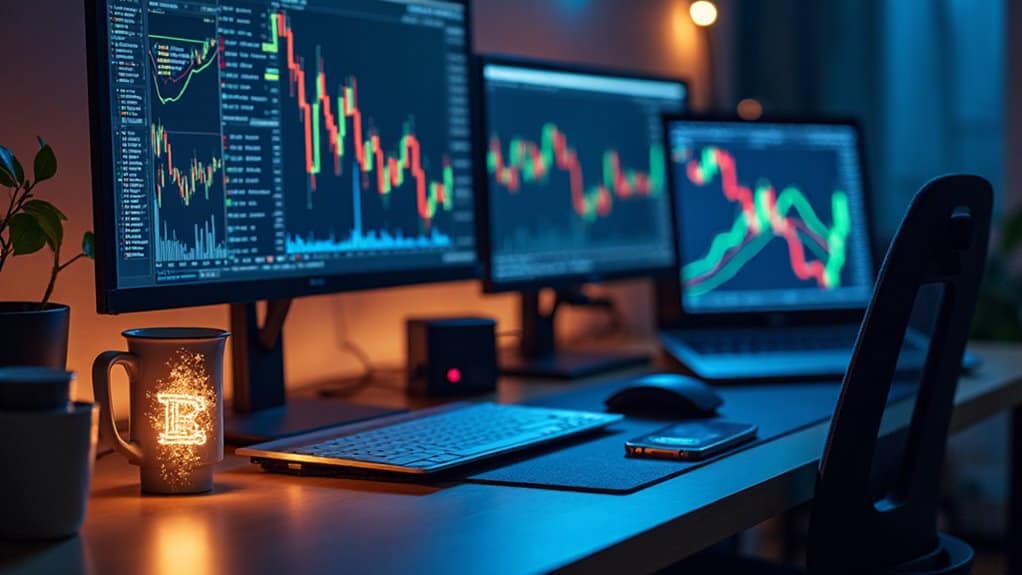How do cryptocurrency markets differ from traditional ones?
They operate 24/7, unlike stock markets with fixed hours. You access global exchanges directly, enabling constant trading. High volatility offers profit potential but increases risk—sharp price swings occur frequently. Bitcoin (BTC) dominates with 40% market share, setting trends. Ethereum (ETH) drives smart contract activity. You trade without intermediaries, using blockchain for settlement. This structure demands strict risk controls.
What risk management tactics should you use?
Always set stop-loss orders to limit losses during sudden drops. Never risk more than 1–2% of your capital per trade. Use position sizing to maintain exposure control. Diversify across top assets like BTC, ETH, and stablecoins such as Tether (USDT). Monitor volume—spikes confirm breakouts; low volume signals weak momentum.
How can you analyze price movements effectively?
Apply technical analysis using candlestick patterns and indicators like RSI and MACD. RSI above 70 signals overbought conditions; below 30 indicates oversold. MACD reveals momentum shifts. Volume validates trends—rising volume strengthens price moves. Chart patterns like engulfing candles highlight reversals. These tools improve timing and decision precision.
Are borrowed products suitable for you?
Borrowed trading allows up to 50:1 amplification, amplifying gains and losses. Contracts for Difference (CFDs) let you speculate without owning assets. But losses can exceed your initial deposit. These instruments suit experienced traders with disciplined strategies. Always use risk controls.
Understanding these variables sharpens your approach in fast-moving digital asset markets.
How Cryptocurrency Markets Differ From Traditional Financial Markets
While traditional financial markets operate during set business hours, cryptocurrency markets never close—offering continuous 24/7 trading across global exchanges.
Why is crypto trading more accessible than traditional trading?
You can trade cryptocurrency anytime, thanks to high liquidity and global crypto exchanges. Unlike centralized stock markets, decentralized finance runs on blockchain technology, removing intermediaries.
How does market volatility affect your investment choices?
Price fluctuations in crypto are rapid—Bitcoin often swings 5–10% daily. This market volatility increases risk but also potential reward.
What tools help you steer through crypto markets?
You rely on technical analysis to interpret market trends and make informed decisions. Social media and regulatory news heavily influence price movements.
Never ignore risk: extreme volatility and changing regulations can impact your crypto trading outcomes.
Key Differences Between Trading and Investing in Cryptocurrencies
You’re either chasing quick moves or playing the long game—know which one you’re doing.
Short-term trading means buying and selling within days or even hours, often relying on price patterns and market noise.
Long-term investing, on the other hand, means holding for months or years, banking on a project’s growth and broader adoption over time.
Trading vs. Holding Period
Trading focuses on short-term price swings, often holding assets for minutes to days, while investing means holding for months or years to capture long-term growth.
You engage in trading to profit from volatility and rapid price movements, using technical analysis to time entries and exits. Investment relies on a long-term strategy, prioritizing asset fundamentals over daily market trends.
Short-term trading demands constant monitoring and quick decisions, exposing you to higher risk of losing capital. The crypto market’s extreme volatility amplifies both potential gains and losses.
Traders analyze charts and utilize positions; investors avoid leverage, aiming to reduce exposure. While trading offers frequent opportunities, it carries intense stress and transaction costs.
Investment smooths out noise, utilizing time to grow wealth steadily. Your choice shapes your approach, risk tolerance, and success.
Short-Term vs. Long-Term Goals
When your goal is to profit from crypto markets, defining your timeframe shapes every decision you make.
Are short-term goals based on volatility or long-term value?
Short-term volatility drives trading strategies, not long-term value. You target quick opportunities for profit from rapid price movements.
How do trading strategies differ?
In crypto trading, you rely on technical analysis and real-time market conditions. You track market trends and adjust fast. Traders monitor price movements hourly, seeking edges in shifting conditions.
What role does risk tolerance play?
Your risk tolerance determines your approach. Trading demands high tolerance; gains can be fast but inconsistent.
Investing focuses on long-term value, with less time commitment and reduced exposure to daily swings.
Do investors ignore short-term changes?
No, but they prioritize fundamentals over short-term volatility. They stay passive, betting on sustained growth despite changing market conditions.
Market Timing and Strategy
While timing the market perfectly remains elusive, your strategy hinges on whether you trade or invest in cryptocurrencies.
How does market timing affect your trading strategy?
Crypto traders focus on short-term price movements, using technical analysis to predict market movement. Day trading cryptocurrency demands constant monitoring of volatility and price trends to execute quick buy and sell decisions.
Why do trading and investing differ in approach?
Your trading strategy relies on real-time data and short-term price shifts, while investing prioritizes long-term growth over immediate market timing. Investors ignore daily volatility, opting for buy and hold.
What risks come with trading?
Trading involves frequent transactions, increasing exposure to losses. Volatility can amplify gains or erode capital fast—90% of day traders reportedly lose money.
Always assess risk tolerance before engaging in active crypto trading.
Top Cryptocurrencies Marketed for Trading Activity
Over a dozen cryptocurrencies dominate trading volume, but five stand out due to market cap, utility, and adoption rates. You’ll often trade cryptocurrency through major crypto exchanges, where BTC leads with 40% of the total market cap.
Why do traders and investors favor the top cryptocurrencies? Because they offer liquidity and responsiveness during market increases. Crypto markets are known for high volatility, making timing essential.
BTC and ETH dominate cryptocurrency trading volume, while USDT provides stability amid swings. Do you need investment advice? Stick to established assets.
BNB offers utility within its exchange ecosystem, giving users fee discounts. SOL competes with ETH by enabling fast, low-cost transactions for DeFi and NFTs.
These top cryptocurrencies shape the market, offering multiple entry points despite risks. Always consider volatility when you trade cryptocurrency.
Understanding Blockchain Technology and Its Role in Trading
Because blockchain underpins every cryptocurrency trade, you need to understand how it guarantees security, transparency, and efficiency in digital markets.
How does blockchain technology support cryptocurrency transactions?
Blockchain technology uses a decentralized digital ledger to record all cryptocurrency transactions securely and immutably. Each transaction is verified by network nodes through consensus mechanisms like proof of work, preventing double-spending.
Why does transparency and trust matter in trading?
The decentralized digital ledger guarantees transparency and trust by making all transaction histories publicly verifiable. This immutability simplifies tracking asset ownership and transfer records.
How do smart contracts enable automated execution?
Smart contracts on platforms like Ethereum allow automated execution of trades when conditions are met, reducing delays and third-party reliance.
What facilitates 24/7 trading?
Blockchain operates continuously, supporting 24/7 trading across global markets. This constant availability helps you analyze market feelings and make informed trading decisions efficiently.
Risk Management Strategies for Volatile Crypto Markets
Since cryptocurrency markets can shift dramatically in minutes, you need effective risk management strategies to protect your capital and maintain long-term trading success.
How can stop-loss orders reduce risk in crypto trading?
You should always use stop-loss orders to automatically exit losing trades at a set level. This limits losses during sudden price fluctuations, especially in high-volatility conditions.
What role does position sizing play in risk management?
By risking only 1–2% of your capital per trade, you control exposure. Even with losses, your overall cryptocurrency portfolio remains intact.
How do technical indicators improve your entry point?
Use RSI and moving averages to identify oversold or overbought levels. These tools align your trading strategy with current market conditions.
Why diversify your cryptocurrency portfolio?
Diversification reduces volatility impact—different coins react uniquely to price fluctuations. Regularly adjust your trading strategy to reflect changing market conditions.
Leveraged Trading and the Use of CFDs in Cryptocurrency Markets
While you can gain amplified exposure to cryptocurrency price movements, margin trading demands careful strategy and discipline due to its heightened risk profile.
How does borrowed trading work in cryptocurrency markets? You use borrowed funds to control larger positions than your initial deposit allows—often up to 50:1 borrowing. This magnifies both potential profits and losses.
Why do traders use CFDs? CFDs let you engage in speculative trading without owning assets. You profit from rapid price changes via long and short positions.
What risks come with CFDs? Losses can exceed your initial deposit. Effective risk management, like stop-loss orders, is crucial.
How do CFDs shape trading strategies? They lower capital barriers and increase flexibility, making advanced strategies accessible in volatile cryptocurrency markets.
Analyzing Market Sentiment and Price Trends With Technical Tools
Technical analysis gives you the tools to interpret market atmosphere and price trends with measurable precision.
How do candlestick charts enhance your understanding of price trends?
Candlestick charts visually display open, high, low, and close prices, helping you spot trend reversals and momentum shifts in crypto assets.
Patterns like doji or engulfing candles signal potential changes.
What role does trading volume play in confirming market atmosphere?
High trading volume confirms strong market atmosphere; low volume suggests weak conviction.
You use volume spikes to validate breakouts or warn of false moves.
Which technical indicators elevate successful trading outcomes?
You rely on the Relative Strength Index (RSI) to detect overbought (>70) or oversold (<30) conditions.
Moving Average Convergence (MACD) tracks momentum shifts.
Combining RSI, MACD, and candlestick charts sharpens your edge.
Conclusion
What Should You Take Away From Crypto Trading Basics?
You now understand how cryptocurrency markets differ from traditional financial markets. They operate 24/7, have lower liquidity in altcoins, and experience higher volatility—Bitcoin’s average annual volatility is around 80%, versus 15% for the S&P 500.
How Can You Apply These Observations Effectively?
Use technical tools like RSI and MACD to analyze price trends, manage risk with stop-loss orders, and avoid emotional decisions. Utilize increases exposure but also risk—over 70% of retail CFD traders lose money.
What’s the Next Step in Your Trading Path?
Focus on education, start with small positions, and trade only on regulated platforms. Blockchain underpins crypto security and transparency, making it essential to understand. Never invest more than you can afford to lose.


Leave a Reply